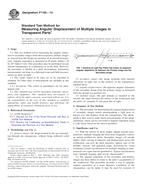Potřebujeme váš souhlas k využití jednotlivých dat, aby se vám mimo jiné mohly ukazovat informace týkající se vašich zájmů. Souhlas udělíte kliknutím na tlačítko „OK“.
ASTM F1165-10
Standard Test Method for Measuring Angular Displacement of Multiple Images in Transparent Parts
Automaticky přeložený název:
Standardní zkušební metoda pro měření úhlového více snímků v průhledné části
NORMA vydána dne 1.5.2010
Informace o normě:
Označení normy: ASTM F1165-10
Poznámka: NEPLATNÁ
Datum vydání normy: 1.5.2010
Kód zboží: NS-49361
Počet stran: 4
Přibližná hmotnost: 12 g (0.03 liber)
Země: Americká technická norma
Kategorie: Technické normy ASTM
Anotace textu normy ASTM F1165-10 :
Keywords:
aircraft transparency, angular displacement, canopy, primary image, secondary image, transparent parts, windscreen, Aerospace transparent enclosures, Angular deviation, Displacement, Field testing--aerospace materials/applications, Image analysis--aerospace materials, Multiple image analysis, Optical materials/properties/tests--aerospace materials, Visual examination--aerospace applications, Windshields, ICS Number Code 17.180.01 (Optics and optical measurement in general)
Doplňující informace
| Significance and Use | ||||
|
With the advent of thick, highly angled aircraft transparencies, multiple imaging has been more frequently cited as an optical problem by pilots. Secondary images (of outside lights), often varying in intensity and displacement across the windscreen, can give the pilot deceptive optical cues of his altitude, velocity, and approach angle, increasing his visual workload. Current specifications for multiple imaging in transparencies are vague and not quantitative. Typical specifications state “multiple imaging shall not be objectionable.” The angular separation of the secondary and primary images has been shown to relate to the pilot's acceptability of the windscreen. This procedure provides a way to quantify angular separation so a more objective evaluation of the transparency can be made. It may be used for research of multiple imaging, quantifying aircrew complaints, or as the basis for windscreen specifications. It should be noted that the basic multiple imaging characteristics of a windscreen are determined early in the design phase and are virtually impossible to change after the windscreen has been manufactured. In fact, a perfectly manufactured windscreen has some multiple imaging. For a particular windscreen, caution should be taken in the selection of specification criteria for multiple imaging, as the inherent multiple imaging characteristics may vary significantly depending upon windscreen thickness, material, or installation angle. Any tolerances that might be established should allow for inherent multiple imaging characteristics. |
||||
| 1. Scope | ||||
|
1.1 This test method covers measuring the angular separation of secondary images from their respective primary images as viewed from the design eye position of an aircraft transparency. Angular separation is measured at 49 points within a 20 by 20° field of view. This procedure may be performed on any aircraft transparency in a laboratory or in the field. However, the procedure is limited to a dark environment. Laboratory measurements are done in a darkened room and field measurements are done at night. 1.2 The values stated in SI units are to be regarded as standard. No other units of measurement are included in this standard. 1.2.1 Exception—The values in parentheses are for information only. 1.3 This standard may involve hazardous materials, operations, and equipment. This standard does not purport to address all of the safety concerns, associated with its use. It is the responsibility of the user of this standard to establish appropriate safety and health practices and determine the applicability of regulatory limitations prior to use. |
||||
| 2. Referenced Documents | ||||
|
Doporučujeme:
Aktualizace zákonů
Chcete mít jistotu o platnosti užívaných předpisů?
Nabízíme Vám řešení, abyste mohli používat stále platné (aktuální) legislativní předpisy.
Chcete vědět více informací? Podívejte se na tuto stránku.




 Cookies
Cookies
